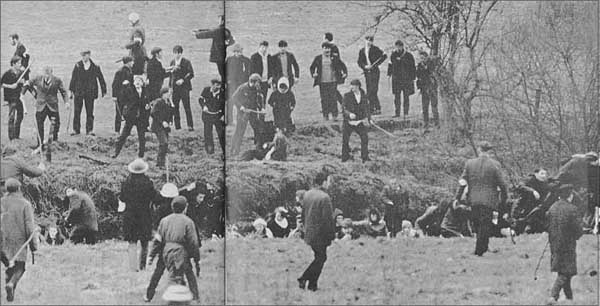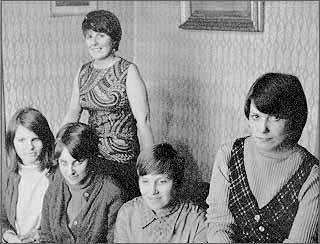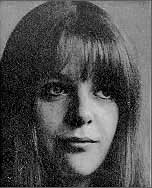
'Burntollet' by Bowes Egan and Vincent McCormack[Key_Events] Key_Issues] [Conflict_Background] PD MARCH: [Menu] [Reading] [Summary] [Background] [Chronology] ['Burntollet'] [Sources] Text: Bowes Egan and Vincent McCormack ... Page Compiled: Fionnuala McKenna
'Did you ever see an Orangeman bleeding green?' AS the march ebbed and staggered, then pushed forward towards the bridge, a sizeable proportion of the walkers had to be carried away by companions because of injury, or were forced off the road and into a field down towards the River Faughan. Manus Armstrong, of Claudy, who knows the locality well, tells how he was physically forced from the roadway: "I made an attempt to get out of the field onto the Ardmore Road, by the gate. But the gateway was full of attackers, and I was driven back by a shower of bottles. The attackers were picking these from high piles, about knee height, just beside the gateway. The piles were about two yards from the gateposts. They were also using stones that were piled along the inside of the hedge. Amongst the attackers were John Haslett and Lloyd Cooke, who were flinging bottles as fast as they could pick them. One of these bottles flew over my head and smashed on the head of a student who, with another, was trying to help a woman who had fallen over the hedge."Dympna Hasson, a girl from the locality, takes up the account . . . "First of all, we were thrown over the ditch into the field. We all ran down the field." Soon she discovered a new danger. A large contingent of attackers had been detailed to deal with just this eventuality. Along the banks of the river sacks full of stones had been unloaded during the night, and now armed crowds streamed from the Ardmore Road into the field, while some pursuers followed from the main Derry Road. Dympna Hasson continues: "We were thrown into the water. About ten girls were tossed in. They threw stones at us when we were in the water, which was about three feet deep. They wouldn't let us out as they were coming at us from both sides. .. . We managed to crawl onto the further side. About six came down and started to hit us. Two used police batons. Three fellows carried me down to the water and threw me in again."Finola Hasson, a Belfast student, tells a similar story: "I asked John Reid what we should do. Before he could answer, someone struck him on the head with a club. He was obviously dazed and could not run so they gathered in and beat him around the head and shoulders. They concentrated on him and only hit me occasionally-mostly with bits of stick. Near us there was an old woman lying on the ground and two students were trying to help her. The attackers beat the students, and refused to allow them take the old woman to the ambulance. John Reid and I started for the road. "A further group surrounded us. I pleaded that he needed a doctor and asked that they help him to the road. They said to call the Pope and he would come and help us. Near the gate of the field two young boys, about fourteen to sixteen, were holding a girl and beating her about the head with sticks. At the other end of the field four or five men were beating something lying on the ground. During this time there was not a policeman in sight." And these were no isolated incidents. Speaking of the attack on young girls, an Irish News reporter tells: "They were scattered screaming into the fields near the road. Some of those near the river were grabbed and thrown over the bridge to fall eight feet into icy, knee-deep water. Many were then unable to leave the river because of men stoning them on each side, and they had to wade for about half a mile before reaching comparative safety."Yet another description of such an attack was published in the Sunday News. Under the heading "Drowning Girl Clubbed", the newspaper cited a Belfast artist, Sorley McNelis, who took part in the march and was forced down to the River Faughan: "I managed to get across alright, but then I looked back and saw a young woman-she must have been about twenty-lying face down in the stream. She must have been unconscious, and the water covered her mouth and nose. She was drowning. I went back to pull her out, but before I got there some men with clubs started hitting at her legs. 
Scores of marchers, trapped by armed attackers, leaped into
the water. Many were beaten back as they tried to scramble out.
In this picture, at least twenty men carrying weapons also wear
the white armbands which proved, in many cases, to be the "badge"
of members of the Special Constabulary. In reply to parliamentary
questions, Home Affairs Minister Robert Porter has said, repeatedly,
that "presence in a photograph is no evidence of a criminal
offence". This is absurd: no person of average sense can doubt that these
men are guilty of a variety of criminal offences, assault, behaviour
likely to cause a breach of the peace, and several others.
On January 7th, the Derry Journal reported the experiences of two girls, Mary Brandon, aged nineteen, and Jean Harkin, aged seventeen, who had come out from the city to join the march: "They had only gone about a mile with the march when stone-throwing began, and buckets of dung were thrown at the marchers, as well as bricks and bottles. The two girls jumped over a hedge and fell in a field. They rose and went on, but were pursued by a group of the attackers. The girls got across to the other bank of the river, but one of them had been injured and had to be carried across the Faughan. This girl lost her shoes in the water. The attackers got round to the other bank without going into the water, and there encircled the girls.Simon Baker, a sixteen-year-old student from Cambell College, Belfast, records an extraordinary sequence of events: "As I reached the field I heard an attacker with a white armband directing others to cut off those who had crossed the river. Evidently they were not satisfied with just getting us off the road. I, too, was forced over the bridge, but was too frightened to cross the river. Suddenly I was surrounded by about five attackers. They brought me to a car and told me to stay there and, stood outside talking. The window was open and I distinctly heard one of them say: 'Right now, we're finished with that lot, let's go up the hill and see what Bunting wants us to do now'."Patricia Lockhart of the nearby village of Feeney, crossed the river when: "A group of about twenty men cornered us in the field. They shouted about throwing us back in the river. I ran to get back across. A man grabbed me and threw me up against the barbed wire fence. I crawled under, and crossed the river. I was crawling up the other bank when a man came up and just kicked me into the river again, I landed on my back in the river."The same girl also testifies that at this time, "there were police, with riot shields, just standing on the road". Margaret Lynch, a young girl from Irwin Crescent, Claudy, had the unusual experience of meeting some of her near neighbours in most unfriendly mood. "The attackers, armed with sticks and stones, would not allow us on the road. They were coming towards us and we had to turn. I jumped into the river, and a stick was thrown after me. We got about halfway up the field when about twenty people with sticks and stones appeared. There was a photographer behind a ditch taking photographs. Two men with sticks battered him to the ground. When they gathered us together in a group they started to say: 'Where's your Pope now? Get your Pope now and he'll help you,' and things like that. After that, they took each fellow out individually and beat each of them with sticks.Norah Hasson, from Park, near Claudy, was also forced to the river: "I saw a young man I know, who comes from the Crescent, Claudy. He said: 'I see girls from Feeney that I know. Before we get them, get the photographer.' A group of around seven was there. One was Kenneth Moore, also of Irwin Crescent, Claudy. They went after the photographer. About four of them battered him with sticks and threw his camera into the water. I ran. When we reached the bottom of the field, I was thrown into the river by a man wearing an armband. I was then struck with a brick on my right shoulder. Then the police came down from the road. They all wore helmets. They stood around us, and threw a scythe in the river."
Quite a number of the Civil Rights marchers had scattered up the embankment that leads to a higher road. Walking along this, a group made up mainly of injured people, came to a house where a clergyman, carrying a walking stick, was surveying the chaos below. They asked for help. Red in the face he gesticulated with his stick: "That's the road to Belfast. You came from there; walk back." Some groups that had crossed the river met an even less Christian reception as they reached this same road, at a spot nearer to the place of attack. Carloads of the original attackers drew up and beat at them once again as they tried to leave the fields. Principal sufferers were the girls who had already been subjected to the treatment described earlier. The identity of the men concerned in this particular attack, which included battering of a press photographer and destruction of his film, is well established by observers from the locality. The group included at least two members of the police force.As wet and injured stragglers made their way down this road towards Claudy, they met and passed a group who had crossed the footbridge and were hurrying in the direction of Derry. Among them was the ubiquitous Derek Eakin.
|
CAIN
contains information and source material on the conflict
and politics in Northern Ireland. CAIN is based within Ulster University. |
|
|
|||
|
Last modified :
|
||
|
| ||

